 |
Contact lens wear is not without its dangers. Individuals who present to the clinic with a case of a red, swollen or otherwise compromised ocular surface are capable of developing an infection from poor lens hygiene, lens overwear, ingress of foreign material or one of any number of other compliance issues. However, aggressive treatment of the issue can turn this negative situation around, regardless of whether it’s possible to identify the underlying cause. Doing so successfully can improve your practice’s standing in the eyes of patients, as most, if not a majority, of them are unaware that the eye care practice is the first place to go when faced with contact lens irritation, rather than the primary care physician, emergency room or urgent care center.
Even more concerning is the realization that many patients who go elsewhere for conjunctival or corneal infections often receive incorrect treatment, resulting in either more healing time, recurrence of the problem or even increased adverse effects such as the loss of visual clarity following resolution. As such, these scenarios represent a chance to build your medical model business and provide patients with targeted treatments their general PCP may not have the expertise or means to give them, increasing the patient’s trust and loyalty to the practice. But, how does one pass the message on to them?
Understanding the Cause
Educating the patient on the practice’s abilities is key, either during the patient exam or with other in-office marketing efforts. Consider incorporating a recording that plays on a loop in the reception area or when the patient is on hold on the phone to remind them that the practice they’re calling or visiting is their primary eye care provider and thus the place to go if they have any contact lens–related issues. Additionally, consider mentioning in the practice’s voicemail recording that infections associated with contact lens wear are also handled at the practice, and to contact the practice’s staff immediately if any concerns arise.
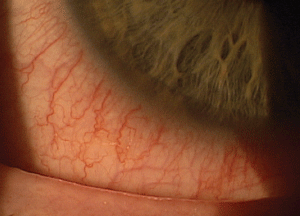 | 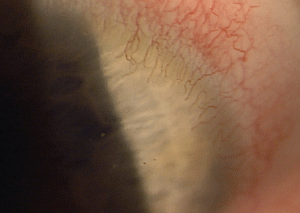 | 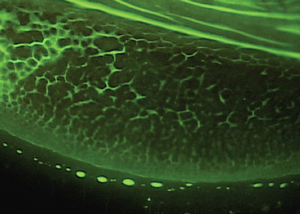 |
| Fig. 1. Conjunctivitis can be a common concern in contact lens patients. Here are, from left to right, (a) bacterial, (b) viral and (c) allergic cases. | ||
Depending on the problem that the patient presents to the clinic with, different origins are likely and so must be addressed differently with each patient to prevent reoccurrence of the same issue. Here are some possible problems that a contact lens patient may present with and how to handle them so as not to lose the patient to lens dropout:
Bacterial conjunctivitis (Figure 1a). Lens hygiene may be to blame for this infection if present in association with contact lens wear. Though rare in comparison to other types of conjunctivitis, this issue needs to be addressed as soon as possible. In addition to treatment, patients must be re-educated on proper lens care and cleaning habits to prevent reoccurrence. In the case of bacterial conjunctivitis, generally there is no visible corneal involvement, though discharge, lash matting and contact lens irritation are often present.
Following resolution of the infection, patients should dispose of their current pair of contact lenses to reduce risk of further problems. Custom specialty lenses, however, may need to be kept out of cost concerns, and must be disinfected well. Bacterial conjunctivitis is typically treated with topical antibiotic therapy, and patients should abstain from contact lens wear until the infection has been cleared and they have finished the entire course of prescribed medication.
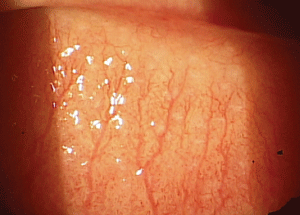 |
| Fig. 2. Large papillae on the underside of the eyelid are hallmark signs of giant papillary conjunctivitis. |
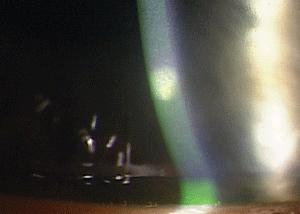 |
| Fig. 3. Infectious infiltrates are generally more painful than their noninfectious counterparts. |
Viral conjunctivitis (Figure 1b). This form of conjunctivitis is commonly confused with bacterial conjunctivitis at presentation; in fact, research shows that eye care practitioners only diagnose this problem correctly approximately 50% of the time due to the many overlapping signs and symptoms between it and bacterial conjunctivitis.1 As such, in the case of a suspected viral conjunctival infection, it is important to evaluate the patient for traces of upper respiratory infection or lymphadenopathy, the latter of which is most closely related to viral origins. Other signs to look for include differences in the types of discharge present (watery indicates viral while mucous or purulent typically indicates bacterial), or the hallmark presence of follicles.
Allergic conjunctivitis (Figure 1c). Though non-infectious in origin (in that it is caused by pollen, pet dander or dust mites rather than a pathogen), this condition is still often misdiagnosed by both primary care providers and urgent care facilities. Allergic conjunctivitis can make contact lens wear more difficult due to the presence of irritating foreign material on the ocular surface, so consider recommending daily disposable contact lens wear to the patient. Signs and symptoms of allergic conjunctivitis include burning and itching and can be treated using topical anti-histamine/mast-cell stabilizer drug combinations.
Giant papillary conjunctivitis (Figure 2). A more chronic form of allergic response strongly correlated with contact lens wear, giant papillary conjunctivitis (GPC) is similarly non-infectious. Large papillae—the hallmark sign—are located on the superior tarsal plate, so evert the upper eyelid to ascertain whether GPC is indeed the patient’s diagnosis. GPC itself is sometimes treated using topical corticosteroids; temporary discontinuation of contact lens wear during treatment helps with resolution.
Infiltrative keratitis (Figure 3). Contact lens-associated corneal infiltrates can occur from either noninfectious or infectious processes. The former appears as multiple infiltrates located across the surface of the cornea with minimal or no fluorescein staining, and the latter appears as a single larger infiltrate that stains positively with fluorescein.2 Noninfectious corneal infiltrates may be associated with contact lens non-compliance, extended lens wear and/or wear of silicone hydrogel contact lenses versus other lens materials. In the case of infectious infiltrates, the bacterial organism invades the corneal tissue through a single area.3-5 Treatment in both cases involves the removal of the patient’s contact lenses and the use of either topical corticosteroids or topical antibiotics.
Accurately diagnosing and treating a variety of contact lens-related complications—the ones above and others unmentioned—is key to getting patients back into their contact lenses safely and keeping them coming to the practice. Proactively discussing potential concerns of noncompliance and hygiene are integral in preventing complications, as is ensuring that patients understand they can contact the office should any of these conditions occur.
1. O’Brien TP, Jeng BH, McDonald M, Raizman MB. Acute conjunctivitis: truth and misconceptions. Curr Med Res Opin. 2009 Aug;25(8):1953-61.
2. Baum J, Dabezies OH Jr. Pathogenesis and treatment of “sterile” midperipheral corneal infiltrates associated with soft contact lens use. Cornea. 2000 Nov;19(6):777-81.
3. Stapleton F, Keay L, Jalbert I, Cole N. The epidemiology of contact lens related infiltrates. Optom Vis Sci. 2007 Apr;84(4):257-72.
4. Chalmers RL, Keay L, McNally J, Kern J. Multicenter case-control study of the role of lens materials and care products on the development of corneal infiltrates. Optom Vis Sci. 2012 Mar;89(3):316-25.
5. Diagnostic and Treatment Algorithms for Ocular Surface Disease States; Supplement. Rev Optom. 2009 Oct.


